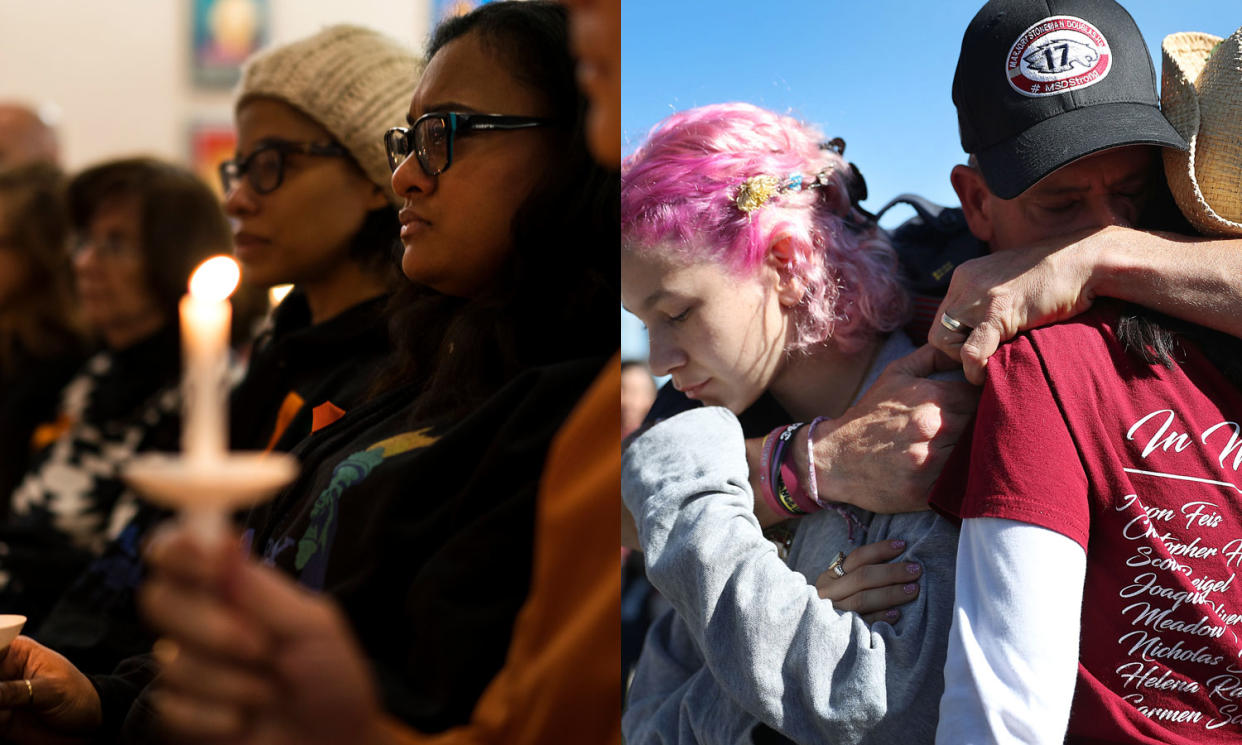Suicides can have a contagion effect – here’s how to combat it

This past week brought devastating reports of three separate deaths by suicides — two, of students Sydney Aiello and Calvin Desir, who had survived the 2018 Parkland school shootings, and the third, of a father in Newtown, Conn., Jeremy Richman, whose 6-year-old was killed in the 2012 Sandy Hook school shootings.
As word spread of all three deaths, many people had a similar reaction — sorrow, followed by a gnawing question: Could the deaths somehow be related?
Turns out that they could have been, due to something known as suicide contagion.
“It is a real phenomenon, we do know that — much like with an infection or disease — in that people who die by suicide can increase that risk for the people most closely connected to them,” April Foreman, a psychologist and board member of the American Association of Suicidology (AAS), tells Yahoo Lifestyle.
Regarding the three recent deaths, Foreman says, “It’s very likely it’s a contagion — a mechanism for transmitting suicide risk between people.”
Still, she suggests not jumping to conclusions. “We have relatively little science about suicide. We have even less research on suicide clusters and contagion. There’s just a lot we don’t know about the issue.”
Further, she notes, “We’re sort of projecting onto these shooting events. You often can’t know for sure if they’re connected until you do a lot of digging into the facts.”
Having worked for the VA as a suicide prevention coordinator, and having done what’s called a behavioral health autopsy after suicides, often seeking evidence of copycat incidents, Foreman says, “Often there are people who know each other, live in the same neighborhood, even posting on the same Facebook page. Like the movie Outbreak, you have to do the digging before you know.”
In its media guide, “Suicide Reporting Recommendations,” the AAS states, “Suicide contagion is the process by which one or more suicides increase the risk of suicidal behavior in others. When an unusually high rate of suicides occurs in a specific region or across a specified period of time, it is called a suicide cluster. Research suggests that certain ways of reporting on suicide can contribute to imitative suicides or suicide clusters. Contagion effects are likely to occur when someone perceives increased benefit of suicide after being exposed to suicidal behavior of others directly or through media coverage. Contagion effects are greatest when suicide is viewed as a means to achieving a goal such as escaping unbearable pain or receiving recognition by way of a strong community response following death.”
Oftentimes people will conflate a suicide cluster with a contagion, Foreman adds. “A cluster is, do we have a bunch that have happened together that are related? While a contagion may be over a period of years — if my mother died by suicide, for example, and then I did 20 years later.”
In assessing risk factors for someone at risk for the contagion of suicide, Foreman explains, “We include proximity,” such as if a person has been present at the suicide death of another, “that’s a powerful event. Emotional closeness is also profound.” In the case of the Parkland students, “they are part of the same school, with a connected traumatic event.”
The phenomenon can also be tracked in relation to celebrity suicides — following the 2014 death by suicide of Robin Williams, there was a rise in suicides nationally; one study put the rise at 10 percent in the months that followed.
“If people feel closely connected to a celebrity who dies by suicide,” Foreman notes, “the media coverage of that can also create the contagion.”
But she stresses that the media is not always, if even often, at fault — and while the way in which one reports a suicide is important, there is a lack of conclusive evidence regarding just how significant it is. Citing a 2015 study from the Journal of Psychology, “Dangerous Words? An Experimental Investigation of the Impact of Detailed Reporting About Suicide on Subsequent Risk,” she says, “we saw no change in suicide risk.”
That said, she adds, “we have safe guidelines on reporting, which are more about de-stigmatization and common courtesy and respect.”
Some recommendations in the AAS guide for reporters to help minimize contagion — which can also be followed by anyone tempted to post about a death by suicide on social media — include the following: Cover the story in a respectful and non-sensationalistic way; avoid single-cause explanations for suicide, which are complex; avoid providing details on exact locations and methods; avoid publishing the content of a suicide note or social media post; steer clear of using photos of mourners; avoid language that “romanticizes” the notion of taking one’s own life.
While it might take some extra-nuanced thought to report responsibly, Forman says, such news should not be suppressed. “Suicide has seen highest levels in the U.S. now since the Great Depression, and we really need to talk about this,” she says. “Just as if there’s a flu epidemic or an Ebola outbreak, the community needs to know.”
If you or someone you know are experiencing suicidal thoughts, call 911, or call the National Suicide Prevention Hotline at 1-800-273-8255 or text HOME to the Crisis Text Line at 741741.
Read more from Yahoo Lifestyle:
Second Parkland Shooting Survivor Apparently Dies By Suicide
Kate Spade, Anthony Bourdain: How celebrity suicides can impact those already on the edge
Follow us on Instagram, Facebook and Twitter for nonstop inspiration delivered fresh to your feed, every day.


